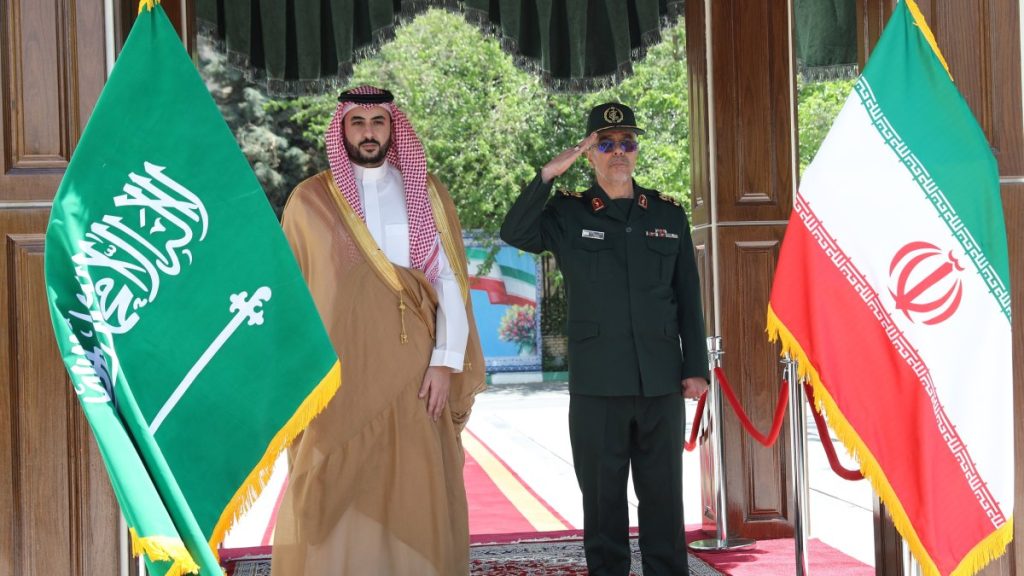The series of visits between Saudi Arabia and Iran, involving officials at various levels of government, has recently expanded with the visit of Saudi Defense Minister Khalid bin Salman to Tehran. This trip marks a potential shift from the symbolic normalization seen in March 2023 to more practical diplomatic and military engagement. Coming amid indirect U.S.-Iran talks in Muscat and Rome, the visit reflects a broader regional recalibration. However, the emerging climate of dialogue between the Saudis and Iranians remains fragile and reversible.
The absence of institutionalized trust mechanisms, persistent proxy rivalries and external spoiler dynamics, particularly from Israel and hardline Iranian factions, may hinder long-term stability in relations between the two regional powerhouses. While the visit has opened a new pathway between the two countries, ensuring Gulf security requires much more than bilateral visits.
Two years after Beijing’s move
In March 2023, under China’s mediation and with the facilitation of Iraqi and Omani officials, Saudi Arabia and Iran restored diplomatic ties after nearly seven years. The Beijing Agreement was widely hailed as a regional breakthrough that could de-escalate tensions in Yemen, Lebanon, Iraq and the broader Gulf. In Yemen and other conflict zones, a certain degree of de-escalation practices and dialogue between the warring parties was observed between March and October 2023 as a result of the agreement.
Yet two years later, many of the structural issues underpinning the Riyadh-Tehran rivalry persist. Against this backdrop, Saudi Defense Minister bin Salman’s April visit to Tehran – the highest-level Saudi military engagement since 1979 – represents an attempt to shift from symbolic normalization to substantive, albeit fragile, dialogue on regional security.
Strategic engagement or realignment?
While normalization restored formal diplomatic relations, the rivalry between Saudi Arabia and Iran has remained alive in Yemen, Iraq, Syria and Lebanon. Following the fall of the Bashar Assad regime, Saudi officials were quick to visit Lebanon and Syria, seeking to capitalize on Iran’s declining influence in those countries.
In this context, Khalid bin Salman’s visit to Tehran indicates Riyadh’s willingness to explore confidence-building measures on security matters cautiously. Yet, this is more a tactical engagement than a strategic alliance. The two states remain deeply divided over political issues, including Iran’s support for non-state armed groups in the region, such as the Houthis, Hezbollah and Hamas, Saudi ties with the U.S. and Israel and contrasting visions for regional leadership within the Islamic world. Nevertheless, the fact that a Saudi defense official was received by Iran’s supreme leader, Ayatollah Khamenei, President Ebrahim Raisi and Major Gen. Mohammad Bagheri suggests that Tehran is equally interested in reducing strategic overstretch amid escalating tensions with Israel and the West.
Limits of dialogue
Riyadh’s deepening diplomatic engagement with Tehran coincides with renewed indirect talks between Washington and Tehran on nuclear and security matters. This convergence raises an important question: Is the Saudi-Iranian detente facilitating a broader diplomatic corridor for U.S.-Iran dialogue? The answer to this question is cautiously affirmative. As Riyadh normalizes ties with Tehran, it undercuts the logic of total Iranian isolation, a pillar of the U.S. maximum pressure strategy. This may provide Tehran with incentives to moderate its regional posture in exchange for economic breathing space. However, at least certain parties in Washington view this dynamic with ambiguity. While regional de-escalation reduces military burdens, it also complicates U.S. leverage if Gulf states pursue increasingly autonomous diplomacy. Saudi Arabia, balancing between American alliance structures and regional pragmatism, is walking a fine line.
Despite the symbolic success of Khalid bin Salman’s visit, several structural risks threaten the durability of this diplomatic thaw. First of all, there is a lack of institutionalization between the two countries. There are no joint military commissions, no conflict de-escalation mechanisms and no verification mechanisms in place. Secondly, there is proxy fragmentation. The Houthis, Popular Mobilization Forces (PMF) factions in Iraq, and other Iranian-aligned groups remain autonomous and unpredictable. Third, spoiler dynamics loom. Israel perceives Saudi-Iranian detente as a threat to its anti-Iranian containment policy and may well act to disrupt it. Fourth, the Islamic Revolutionary Guard Corps (IRGC) and Saudi hardliners may resist deeper normalization efforts if their core interests appear threatened on both sides. Thus, while the climate for dialogue is real, so is its fragility. Without multilateral anchoring and third-party mechanisms, the region risks reverting to cycles of miscalculation and crisis.
Khalid bin Salman’s visit to Tehran marks a milestone in Saudi-Iranian relations, potentially opening up space for a new regional dialogue architecture. Yet that architecture remains under construction and rests on shaky foundations. Without institutional guarantees, shared threat perceptions, and third-party support, the rapprochement risks being remembered as a temporary strategic pause rather than a durable realignment. Suppose regional actors fail to capitalize on this momentum. In that case, the Middle East may once again drift into a landscape shaped more by proxy warfare and strategic mistrust than by pragmatic diplomacy. The opportunity is real – but so is the risk of its dissipation.


